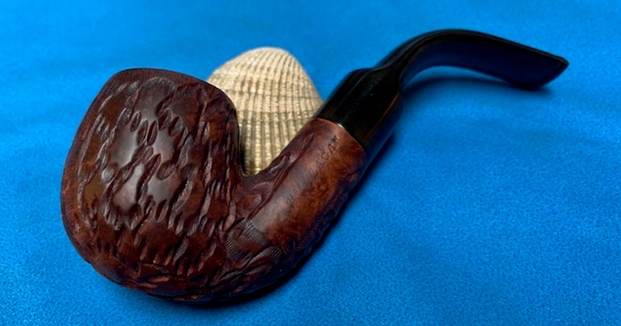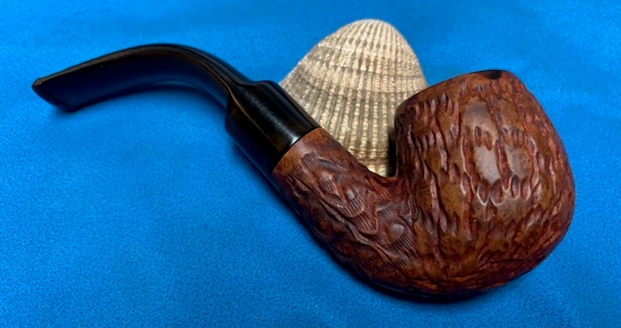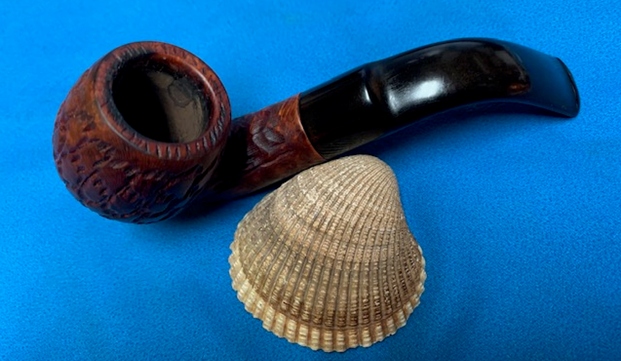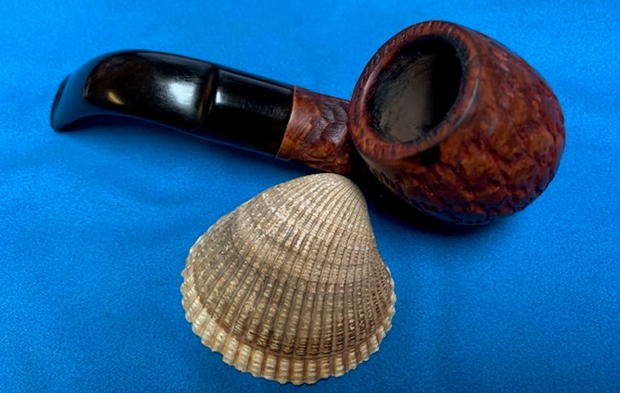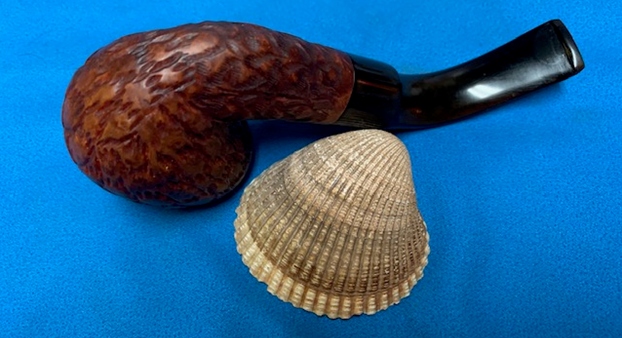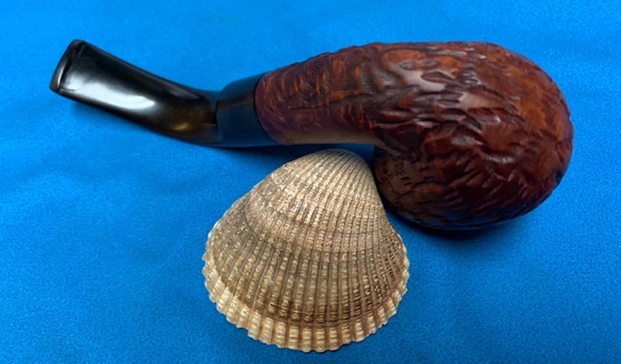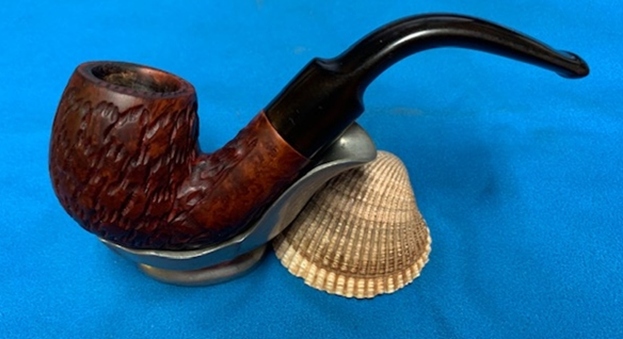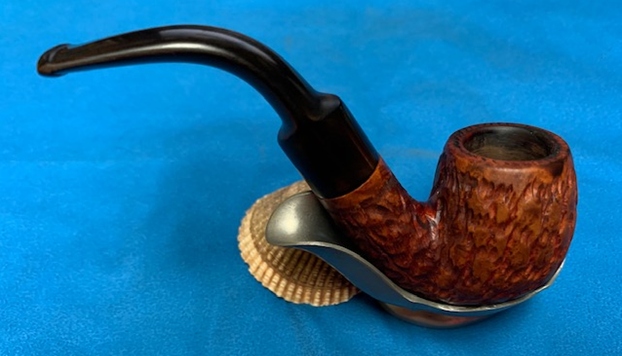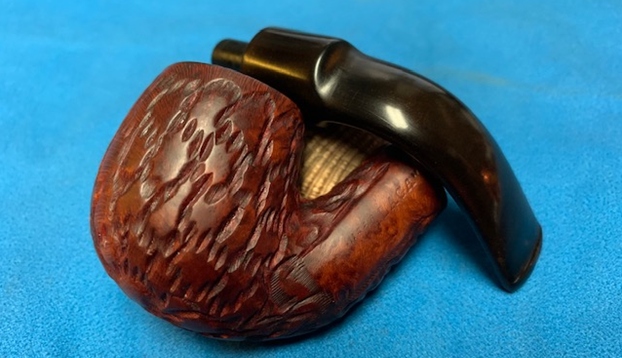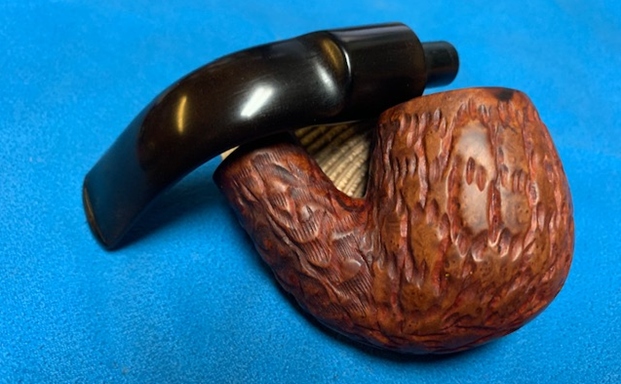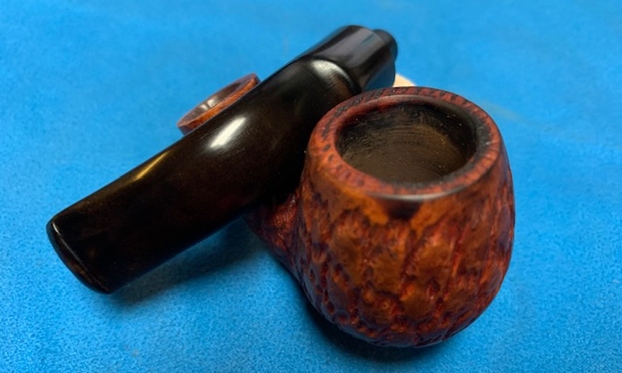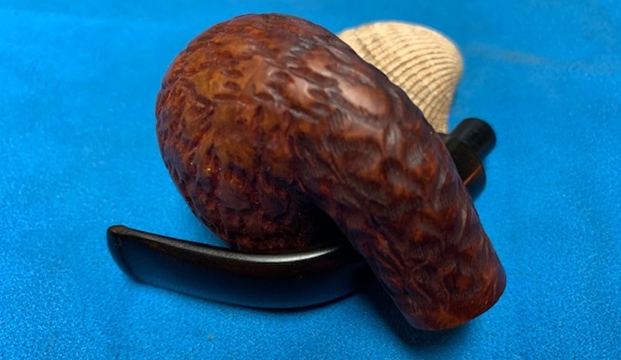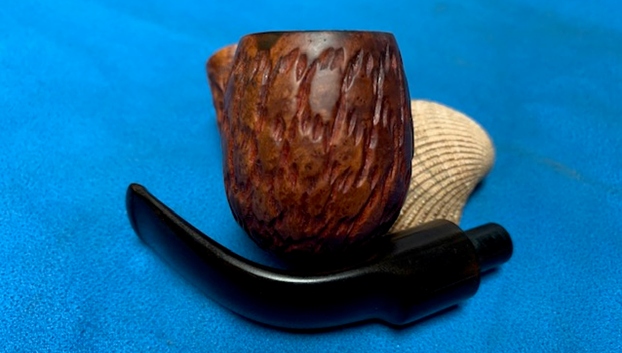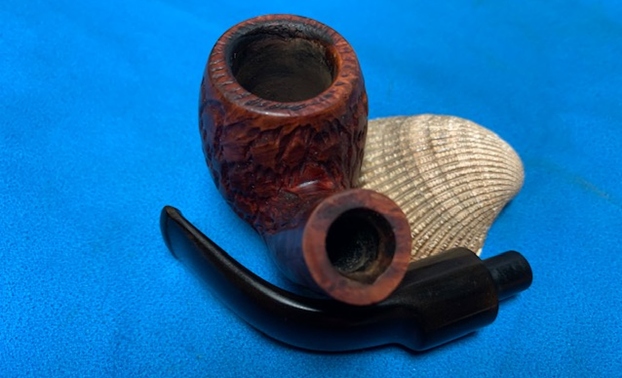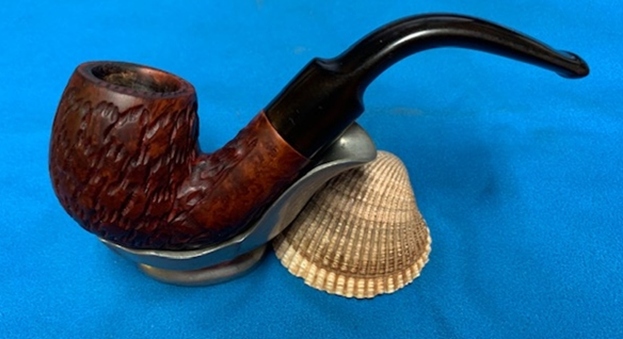Blog by Steve Laug
 The next pipe on the table is a “Malaga” pipe that is one of Alex’s Malaga collection. It is a bent billiard with a carved rustication pattern around the bowl and shank that is unlike any of the other Malaga pipes that I have worked on. The rustication pattern is definitely interesting and from what I can see makes up for some mediocre grain. It came with a ¾ bent saddle vulcanite stem. The carver did a great job of uniquely shaping the pipe and rusticating it to give it a unique character. The bowl had a light cake that seems to have been reamed quite recently. The rim top had some significant burn damage on the inner edge and top toward the front of the bowl. The sides of the bowl and shank are very dirty with grime and oils from prolonged use. The stamping on the left side of the shank read “MALAGA”. The vulcanite stem was heavily oxidized and had tooth dents and chatter on the top and the underside of the stem. The button was worn on both sides. I took photos of the pipe before I started the cleanup work.
The next pipe on the table is a “Malaga” pipe that is one of Alex’s Malaga collection. It is a bent billiard with a carved rustication pattern around the bowl and shank that is unlike any of the other Malaga pipes that I have worked on. The rustication pattern is definitely interesting and from what I can see makes up for some mediocre grain. It came with a ¾ bent saddle vulcanite stem. The carver did a great job of uniquely shaping the pipe and rusticating it to give it a unique character. The bowl had a light cake that seems to have been reamed quite recently. The rim top had some significant burn damage on the inner edge and top toward the front of the bowl. The sides of the bowl and shank are very dirty with grime and oils from prolonged use. The stamping on the left side of the shank read “MALAGA”. The vulcanite stem was heavily oxidized and had tooth dents and chatter on the top and the underside of the stem. The button was worn on both sides. I took photos of the pipe before I started the cleanup work. 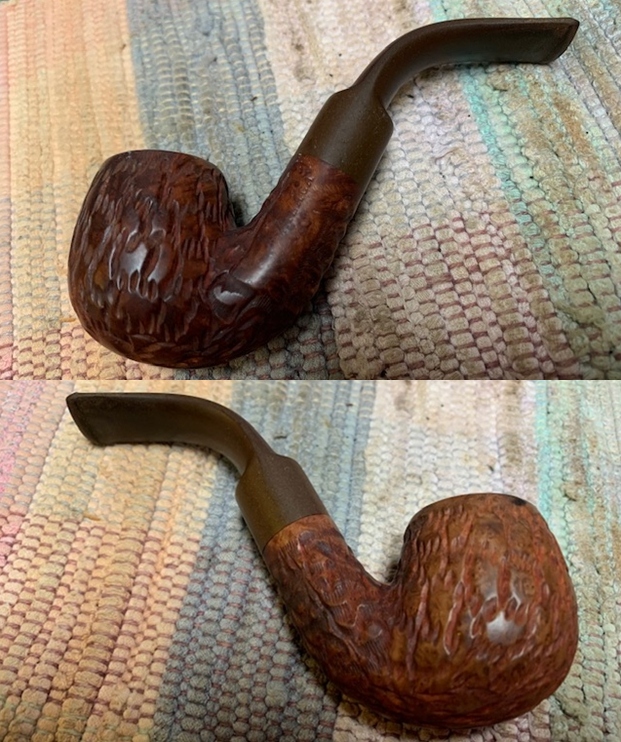
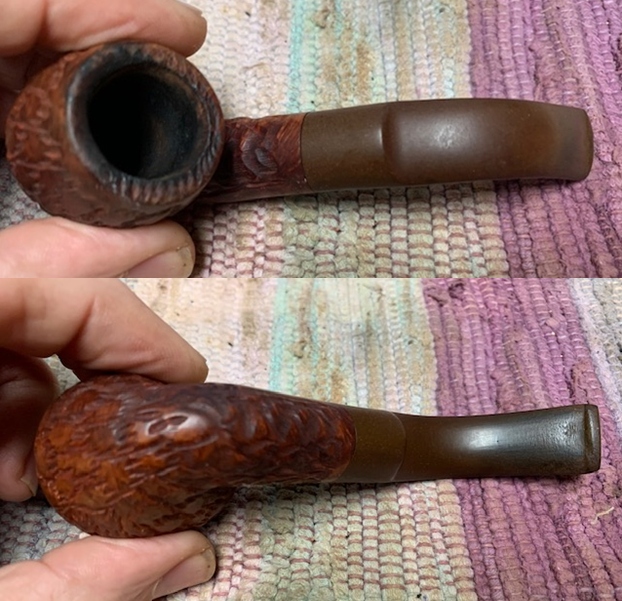 I took a close up photo of the bowl and rim to capture the condition of the pipe before I started my cleanup work. The rim top had some major burn damage and darkening on the front top and inner edge of the bowl. The burn marks appeared to be quite deep on the inner edge and had burned the rustication off the front top of the bowl. The stem is deeply oxidized and dirty and there is tooth damage on the surface of the stem and damage to the button edges.
I took a close up photo of the bowl and rim to capture the condition of the pipe before I started my cleanup work. The rim top had some major burn damage and darkening on the front top and inner edge of the bowl. The burn marks appeared to be quite deep on the inner edge and had burned the rustication off the front top of the bowl. The stem is deeply oxidized and dirty and there is tooth damage on the surface of the stem and damage to the button edges. 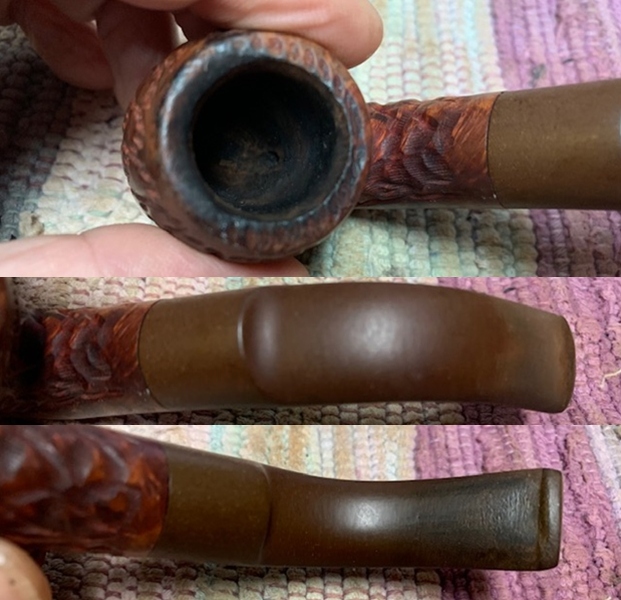 I took a photo of the stamping on the left side of the shank on the smooth panel. It read as noted above.
I took a photo of the stamping on the left side of the shank on the smooth panel. It read as noted above.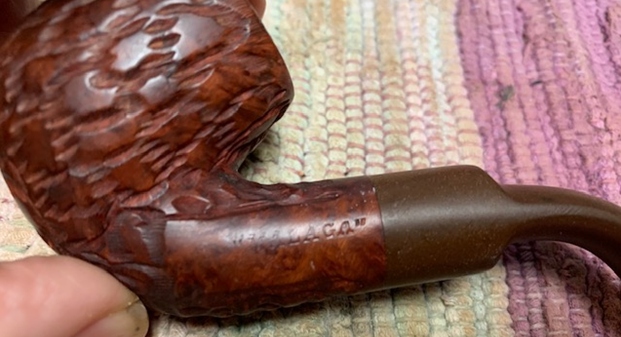 I took the stem off the shank and took a photo of the overall look of the pipe. It is quite attractive and certainly a unique rustication.
I took the stem off the shank and took a photo of the overall look of the pipe. It is quite attractive and certainly a unique rustication.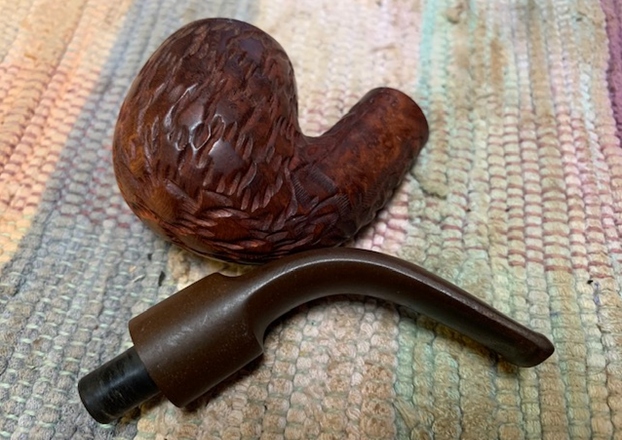 I am also including the link to a blog that I wrote that gives some of the history of the Malaga brand and the Malaga Pipe Shop in Royal Oak, Michigan in the USA. I have written an earlier blog to give a little history of the Malaga Brand and the pipemaker, George Khoubesser. Here is the link – https://rebornpipes.com/tag/malaga-pipes/.That blog also includes links to a catalogue and the history of the pipemaker George Khoubesser. Follow the link to get a feel for the brand and the pipemaker.
I am also including the link to a blog that I wrote that gives some of the history of the Malaga brand and the Malaga Pipe Shop in Royal Oak, Michigan in the USA. I have written an earlier blog to give a little history of the Malaga Brand and the pipemaker, George Khoubesser. Here is the link – https://rebornpipes.com/tag/malaga-pipes/.That blog also includes links to a catalogue and the history of the pipemaker George Khoubesser. Follow the link to get a feel for the brand and the pipemaker.
There was a light cake in the bowl so I reamed it with a Savinelli Fitsall pipe knife to remove the cake. It did not take too much work to clean out the remnants. I sanded the bowl with 220 grit sandpaper wrapped around a piece of dowel. I was happy to see that the bowl looked very good. There was no heat damage.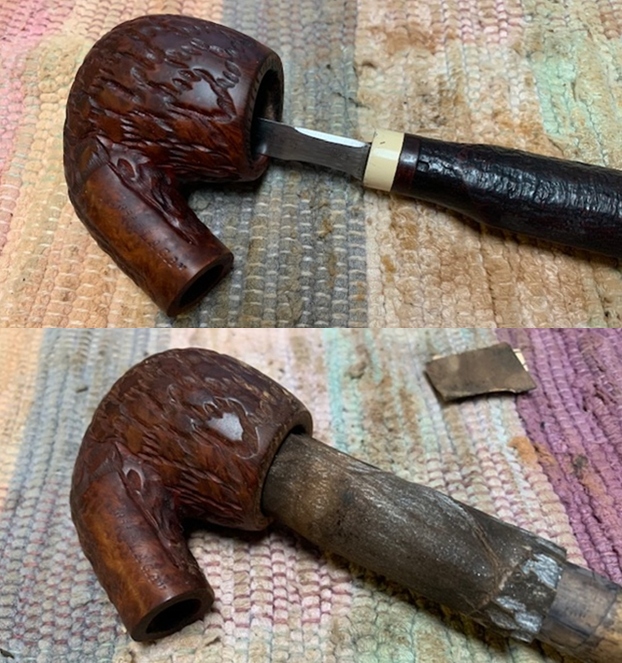 I lightly topped the bowl with 220 grit sandpaper on a topping board. Once it was smooth I wiped the rim top down with a cotton pad and alcohol. I used super glue and briar dust to build up the damage on the rim top and inner edge of the bowl. I used a folded piece of 220 grit sandpaper to give the rim edge a slight bevel and smooth it out.
I lightly topped the bowl with 220 grit sandpaper on a topping board. Once it was smooth I wiped the rim top down with a cotton pad and alcohol. I used super glue and briar dust to build up the damage on the rim top and inner edge of the bowl. I used a folded piece of 220 grit sandpaper to give the rim edge a slight bevel and smooth it out.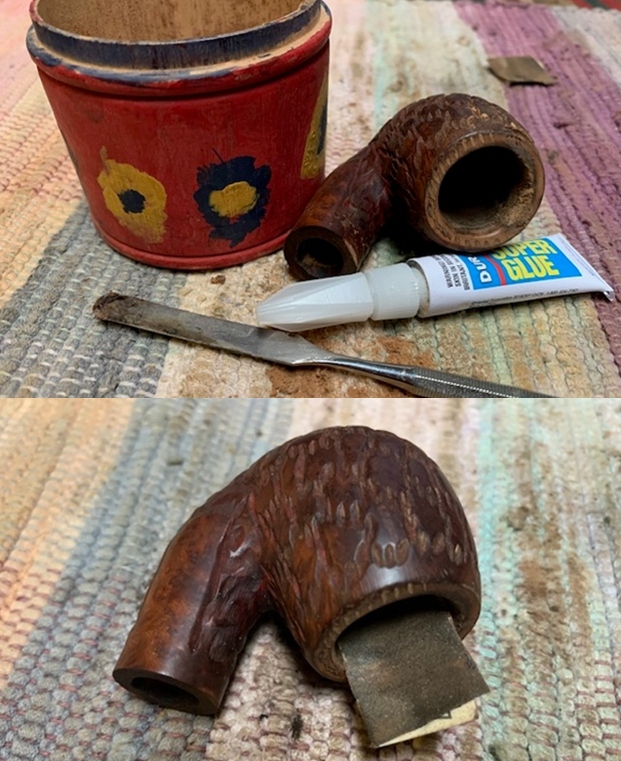 I lightly topped the bowl again to smooth it out. I used a Dremel and burr to cut new grooved rustication into the bowl top to match the original rustication. I stained the newly repaired and carved rim top with an Oak stain pen to match the rest of the surrounding briar. I was happy with the way the repair looked.
I lightly topped the bowl again to smooth it out. I used a Dremel and burr to cut new grooved rustication into the bowl top to match the original rustication. I stained the newly repaired and carved rim top with an Oak stain pen to match the rest of the surrounding briar. I was happy with the way the repair looked.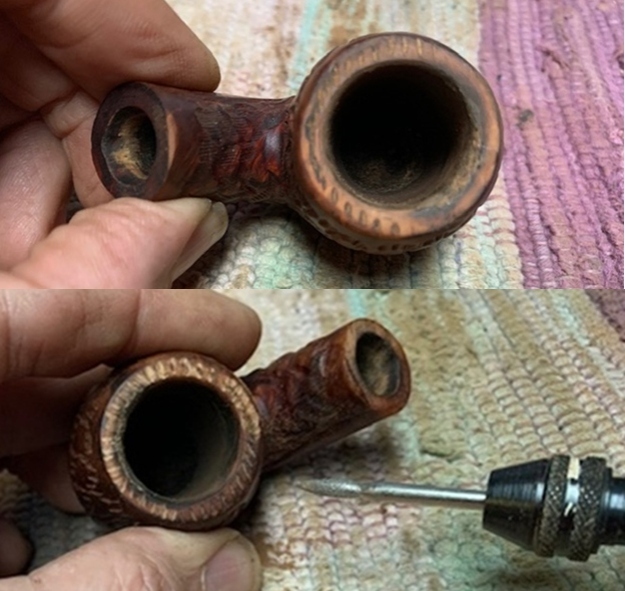
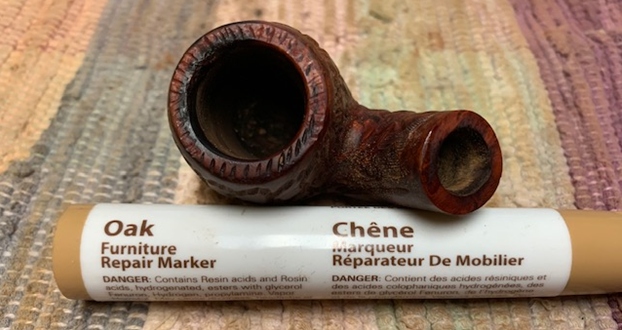 I scrubbed out the mortise and the airway in the shank and the stem with alcohol, cotton swabs and pipe cleaners. Once it was finished the pipe smelled much better.
I scrubbed out the mortise and the airway in the shank and the stem with alcohol, cotton swabs and pipe cleaners. Once it was finished the pipe smelled much better. 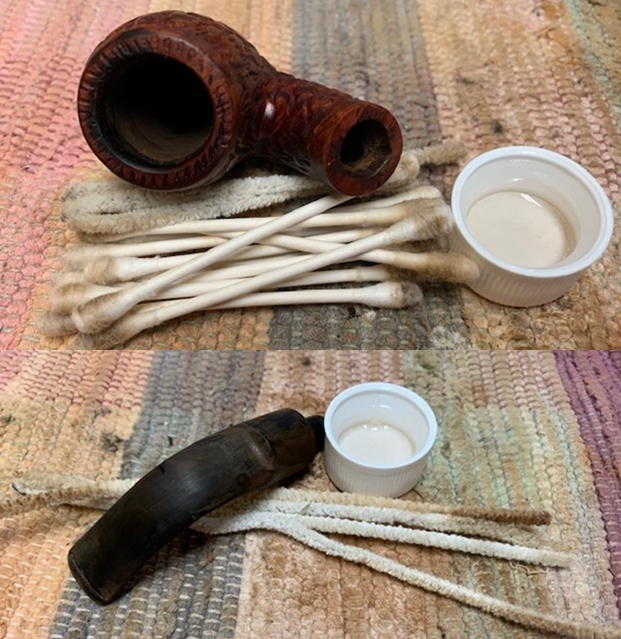 I worked some Before & After Restoration Balm into the surface of the briar with my fingertips and a horsehair shoe brush to clean, enliven and protect it. I let the balm sit for a little while and then buffed with a cotton cloth to raise the shine. The following photos show the bowl at this point in the restoration process. I am very happy with the results.
I worked some Before & After Restoration Balm into the surface of the briar with my fingertips and a horsehair shoe brush to clean, enliven and protect it. I let the balm sit for a little while and then buffed with a cotton cloth to raise the shine. The following photos show the bowl at this point in the restoration process. I am very happy with the results. 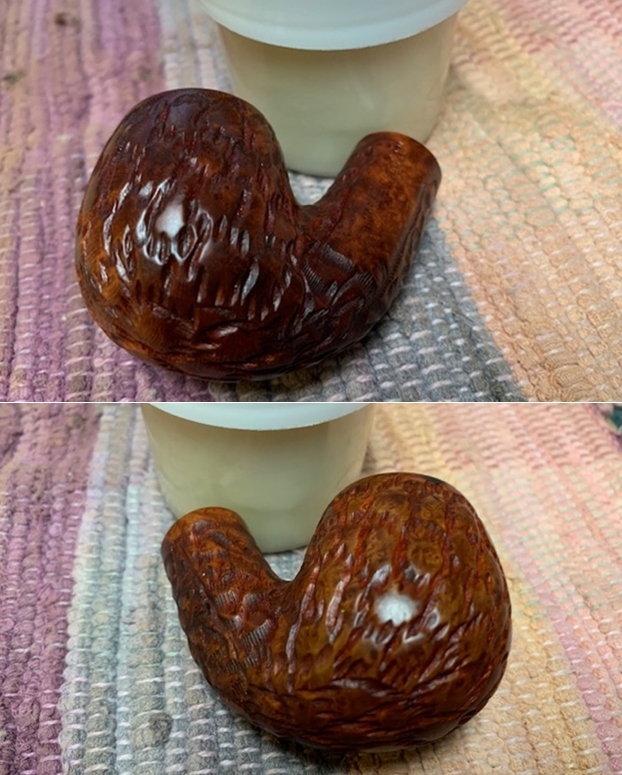
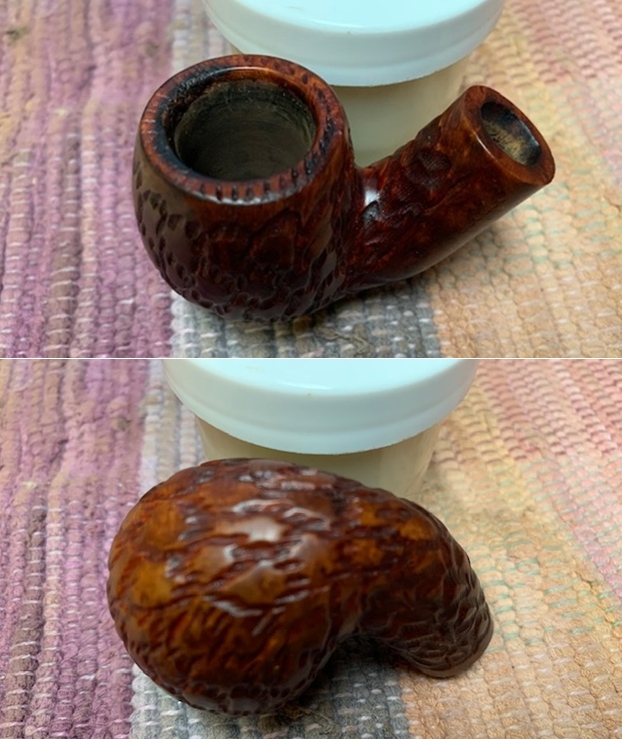
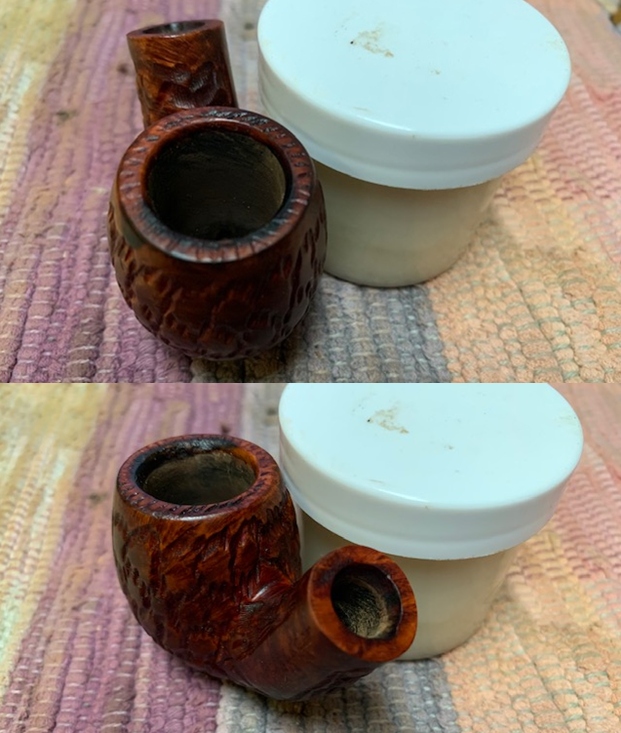 I turned to the stem and scrubbed the oxidation with Soft Scrub All Purpose cleaner. I scrubbed the surface with the cleaner and cotton pads. I was able to remove a lot of the oxidation.
I turned to the stem and scrubbed the oxidation with Soft Scrub All Purpose cleaner. I scrubbed the surface with the cleaner and cotton pads. I was able to remove a lot of the oxidation. 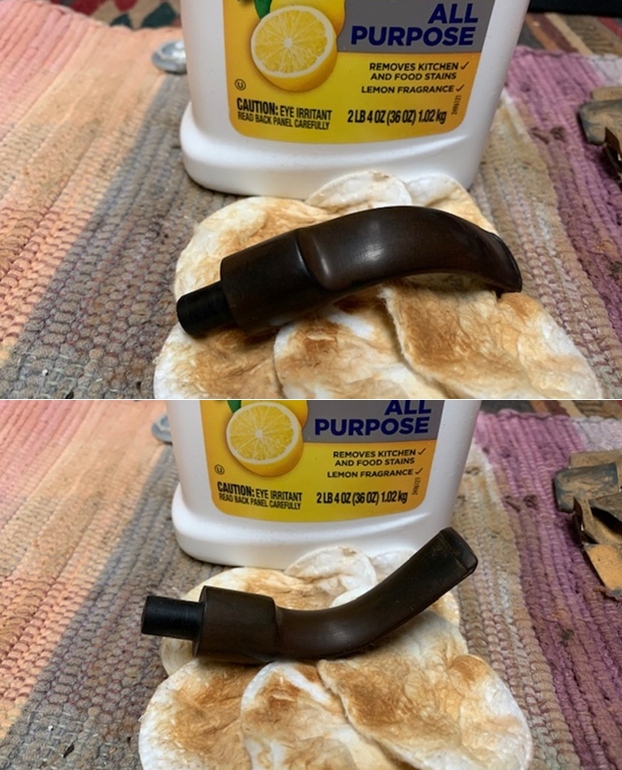 I sanded out the tooth marks on the underside of the stem and was able to remove most of them. There was one larger tooth mark that remained that I filled in with Loctite 380 Black Instant Adhesive. Once the repair cured I sanded it with 220 grit sandpaper to smooth it out and to remove the remaining oxidation.
I sanded out the tooth marks on the underside of the stem and was able to remove most of them. There was one larger tooth mark that remained that I filled in with Loctite 380 Black Instant Adhesive. Once the repair cured I sanded it with 220 grit sandpaper to smooth it out and to remove the remaining oxidation.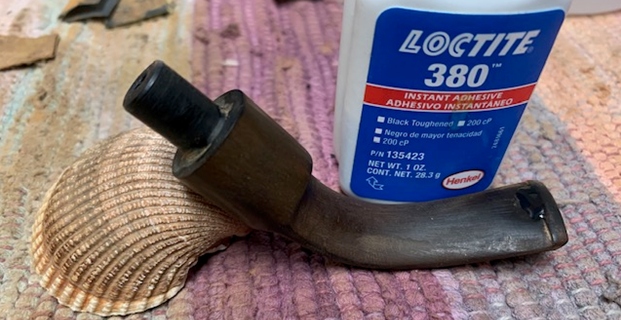 I reshaped the button edges with 220 grit sandpaper and a needle file. I sanded the stem with 220 grit sandpaper to remove the remaining oxidation and started the polishing the stem with 400 grit wet dry sandpaper.
I reshaped the button edges with 220 grit sandpaper and a needle file. I sanded the stem with 220 grit sandpaper to remove the remaining oxidation and started the polishing the stem with 400 grit wet dry sandpaper. 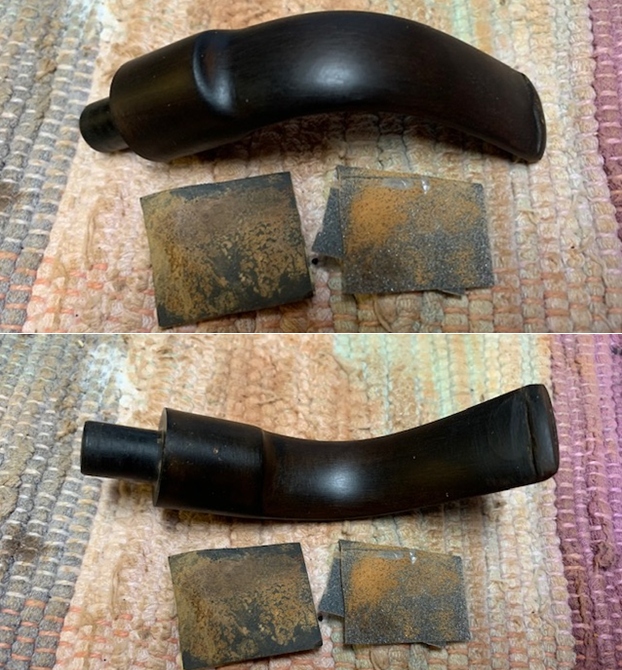 I polished the stem with micromesh sanding pads – wet sanding with 1500-12000 grit sanding pads. I wiped it down after each sanding pad Obsidian Oil. I finished by polishing it with Before & After Pipe Stem Polish both fine and extra Fine and then wiped it down with a final coat of Obsidian Oil.
I polished the stem with micromesh sanding pads – wet sanding with 1500-12000 grit sanding pads. I wiped it down after each sanding pad Obsidian Oil. I finished by polishing it with Before & After Pipe Stem Polish both fine and extra Fine and then wiped it down with a final coat of Obsidian Oil. 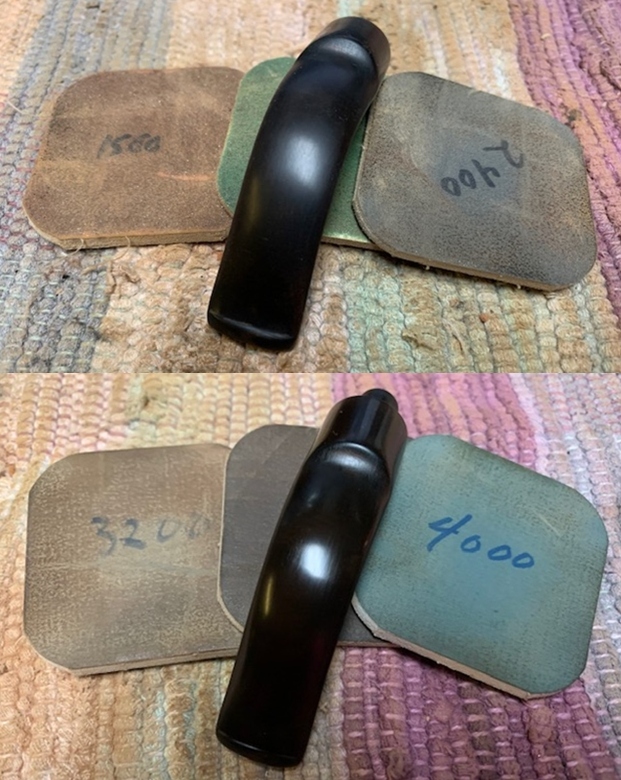
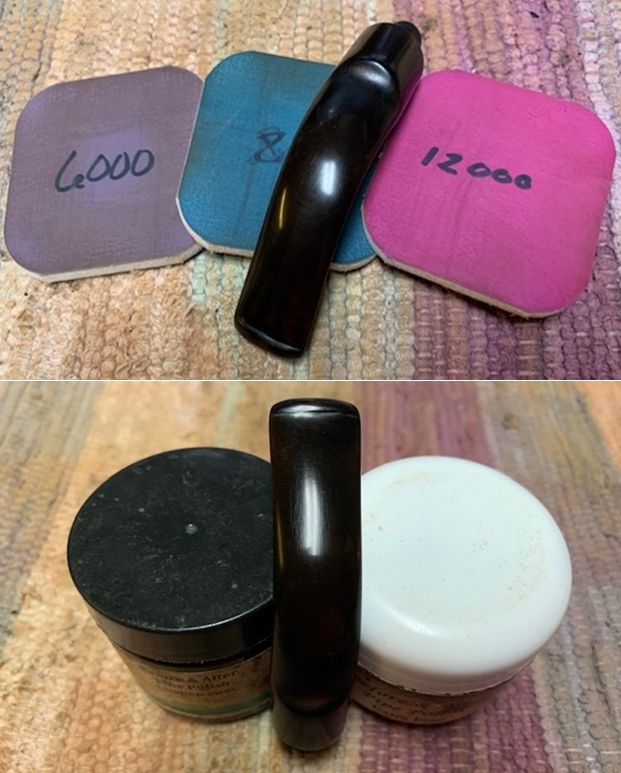 This Malaga Rusticated/Carved Bent Billiard with a vulcanite saddle stem turned out to be a real beauty. It has a unique rustication around the bowl that is unlike other Malaga pipes that I have worked on. The carver really maximized that with the shape of the pipe. Everything about the pipe – the rustication on the shank and sides, the rusticated rim top and the cut of the briar work well to highlight the shape of the bowl. I polished stem and the bowl with Blue Diamond polish on the buffing wheel and the finish just popped and came alive. I gave the bowl and the stem multiple coats of carnauba wax. I buffed the pipe with a clean buffing pad to raise the shine. I hand buffed it with a microfiber cloth to deepen the shine. The pipe polished up pretty nicely. The pipe took on life with the buffing. The rich oil cured colour works well with the polished vulcanite stem. The finished pipe has a rich look that is quite catching. Have a look at it with the photos below. The shape, finish and flow of the pipe and stem are very well done. The dimensions are Length: 5 inches, Height: 1 ½ inches, Outside diameter of the bowl: 1 ¼ inches, Chamber diameter: ¾ of an inch. The pipe will back in the box of pipes that I am working on fro Alex. I am looking forward to what he will think of this one. Thanks for walking through the restoration with me as I worked over another estate pipe.
This Malaga Rusticated/Carved Bent Billiard with a vulcanite saddle stem turned out to be a real beauty. It has a unique rustication around the bowl that is unlike other Malaga pipes that I have worked on. The carver really maximized that with the shape of the pipe. Everything about the pipe – the rustication on the shank and sides, the rusticated rim top and the cut of the briar work well to highlight the shape of the bowl. I polished stem and the bowl with Blue Diamond polish on the buffing wheel and the finish just popped and came alive. I gave the bowl and the stem multiple coats of carnauba wax. I buffed the pipe with a clean buffing pad to raise the shine. I hand buffed it with a microfiber cloth to deepen the shine. The pipe polished up pretty nicely. The pipe took on life with the buffing. The rich oil cured colour works well with the polished vulcanite stem. The finished pipe has a rich look that is quite catching. Have a look at it with the photos below. The shape, finish and flow of the pipe and stem are very well done. The dimensions are Length: 5 inches, Height: 1 ½ inches, Outside diameter of the bowl: 1 ¼ inches, Chamber diameter: ¾ of an inch. The pipe will back in the box of pipes that I am working on fro Alex. I am looking forward to what he will think of this one. Thanks for walking through the restoration with me as I worked over another estate pipe.